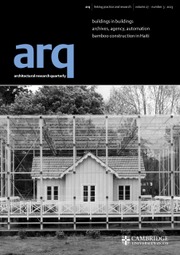No CrossRef data available.
Article contents
Parallax as distortion within city space
Published online by Cambridge University Press: 22 September 2025
Extract
This paper explores the role of parallax in architecture and the so-called ‘parallax gap’ proposed by philosopher Slavoj Žižek in 2009. For Žižek the parallax gap is grounded in psychoanalytic short circuits, prompting a hypothesis about postmodern conflicts within architecture. While the concept of parallax has appeared within architecture at various points historically, Žižek’s parallax gap affords a possibility for the redirection of the viewer’s gaze away from the architectural object to the spaces inflected by, and between, neighbouring urban fabric. Reflecting on the potentialities of interrogating architecture and urban space psychoanalytically, I argue for an expansion of parallax focused on understanding spatial dislocations and disorientations. The result retraces parallax in urban space research, catering for a fertile investigation at the intersection of architecture, culture, politics, and psychoanalysis.
Information
- Type
- Full Paper
- Information
- Copyright
- © The Author(s), 2025. Published by Cambridge University Press

